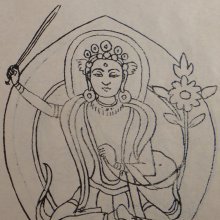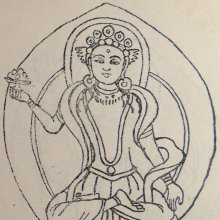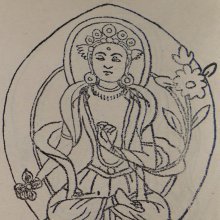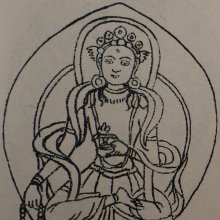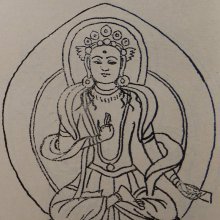Avalokita: 17 definitions
Introduction:
Avalokita means something in Buddhism, Pali, Hinduism, Sanskrit, Marathi. If you want to know the exact meaning, history, etymology or English translation of this term then check out the descriptions on this page. Add your comment or reference to a book if you want to contribute to this summary article.
Images (photo gallery)
(+1 more images available)
In Hinduism
Natyashastra (theatrics and dramaturgy)
Source: Wisdom Library: Nāṭya-śāstra1) Avalokita (अवलोकित, “looking down”) also refers to a type of glance (dṛṣṭi), defined in the Nāṭyaśāstra chapter 8. Accordingly, the instructions for this glance are: “(turning the eyeballs) towards the ground”.
2) Avalokita (अवलोकित) refers to one of the thirty-three alaṃkāras (embellishments), according to the Nāṭyaśāstra chapter 29. It is also known as avaloka. These alaṃkāras, or, ‘embellishments of song’, depend upon the four types of varṇas, which refers to a specific order of musical notes (svara). They are attached to the songs of seven forms, although not generally used in the dhruvās.
According to the Nāṭyaśāstra, “avalokita is when in the udvāhita the repeated kalās are in the descending scale”.
Source: archive.org: The mirror of gesture (abhinaya-darpana)1) Avalokita (looking down): looking down. Usage: looking at a shadow, reflection (vicāra), bed, study, looking at one’s own body.
2) A type of glance (or facial expression): Avalokita: looking down. Usage: study (paṭhanā), reflection (vicāra).

Natyashastra (नाट्यशास्त्र, nāṭyaśāstra) refers to both the ancient Indian tradition (shastra) of performing arts, (natya—theatrics, drama, dance, music), as well as the name of a Sanskrit work dealing with these subjects. It also teaches the rules for composing Dramatic plays (nataka), construction and performance of Theater, and Poetic works (kavya).
Jyotisha (astronomy and astrology)
Source: Wisdom Library: Brihat Samhita by VarahamihiraAvalokita (अवलोकित) refers to “seeing” (an eclipsed disc), according to the Bṛhatsaṃhitā (chapter 5), an encyclopedic Sanskrit work written by Varāhamihira mainly focusing on the science of ancient Indian astronomy astronomy (Jyotiṣa).—Accordingly, “If there should be both lunar and solar eclipses in one month, princes will suffer both from dissensions among their own army and from wars. [...] These evil effects, resulting from planetary look at eclipsed disc, apply as well to the time of termination of the eclipse as to its commencement. If Jupiter, a beneficent planet, should also see [i.e., avalokita] the eclipsed disc, the evils described will vanish in just the same way as the flame of fire dies out when water is poured over it”.

Jyotisha (ज्योतिष, jyotiṣa or jyotish) refers to ‘astronomy’ or “Vedic astrology” and represents the fifth of the six Vedangas (additional sciences to be studied along with the Vedas). Jyotisha concerns itself with the study and prediction of the movements of celestial bodies, in order to calculate the auspicious time for rituals and ceremonies.
Shaktism (Shakta philosophy)
Source: Google Books: ManthanabhairavatantramAvalokita (अवलोकित) refers to “having viewed” (the tree), according to the Ambāmatasaṃhitā (verse 8.88cd-94a).—Accordingly, “[...] Ciñcinin (i.e., Śrīnātha) viewed (avalokita) the (tamarind) tree with the support of (the energy of the goddess) Ciñcinī and when it was broken, as a sign (of his) realisation, (the goddess) brought it back to life. Instructed in restraint and grace, she, the supreme power, was transmitted to him in a pure form and so he is said to be Ciñcinin. (Thus) by virtue of (this) power there are two Siddhas with the (same) name, Śrīnātha and Aṃvilī. [...]”.

Shakta (शाक्त, śākta) or Shaktism (śāktism) represents a tradition of Hinduism where the Goddess (Devi) is revered and worshipped. Shakta literature includes a range of scriptures, including various Agamas and Tantras, although its roots may be traced back to the Vedas.
In Buddhism
Tibetan Buddhism (Vajrayana or tantric Buddhism)
Source: Wisdom Library: Tibetan BuddhismAvalokita (अवलोकित) is the name of Vidyārāja (i.e., “wisdom king”) mentioned as attending the teachings in the 6th century Mañjuśrīmūlakalpa: one of the largest Kriyā Tantras devoted to Mañjuśrī (the Bodhisattva of wisdom) representing an encyclopedia of knowledge primarily concerned with ritualistic elements in Buddhism. The teachings in this text originate from Mañjuśrī and were taught to and by Buddha Śākyamuni in the presence of a large audience (including Avalokita).
Source: archive.org: The Indian Buddhist IconographyAvalokita (अवलोकित) or Avalokitalokeśvara refers to number 44 of the 108 forms of Avalokiteśvara found in the Machhandar Vahal (Kathmanu, Nepal). [Machhandar or Machandar is another name for for Matsyendra.].
Accordingly,—
“Avalokita also is one-faced and two-armed and sits in the same attitude on a lotus. He wields the sword in his right hand and holds the stem of a lotus against the chest with his left”.
The names of the 108 deities [viz., Avalokita] possbily originate from a Tantra included in the Kagyur which is named “the 108 names of Avalokiteshvara”, however it is not yet certain that this is the source for the Nepali descriptions. Tibetan Buddhism includes schools such as Nyingma, Kadampa, Kagyu and Gelug. Their primary canon of literature is divided in two broad categories: The Kangyur, which consists of Buddha’s words, and the Tengyur, which includes commentaries from various sources. Esotericism and tantra techniques (vajrayāna) are collected indepently.
Mahayana (major branch of Buddhism)
Source: academia.edu: A Study and Translation of the GaganagañjaparipṛcchāAvalokita (अवलोकित) refers to “that which can be looked upon” (as opposed to Anavalokita—‘(that which) nobody can look at’), according to the Gaganagañjaparipṛcchā: the eighth chapter of the Mahāsaṃnipāta (a collection of Mahāyāna Buddhist Sūtras).—Accordingly, as Bodhisattva Gaganagañja explains to Bodhisattva Ratnaśrī what kind of concentration should be purified: “[...] (4) [when the Bodhisattvas attain] the concentration called ‘The sun’, all good qualities will increase. (5) [when the Bodhisattvas attain] the concentration called ‘Virtue’, there will be no impurity; (6) [when the Bodhisattvas attain] the concentration called ‘The highest peak’, nobody can look at the crown of the head (anavalokita-mūrdha); [...]”.
Source: De Gruyter: A Buddhist Ritual Manual on AgricultureAvalokita (अवलोकित) refers to “(particular) look”, according to the Vajratuṇḍasamayakalparāja, an ancient Buddhist ritual manual on agriculture from the 5th-century (or earlier), containing various instructions for the Sangha to provide agriculture-related services to laypeople including rain-making, weather control and crop protection.—Accordingly [after the four great kings requested the Bhagavān], “Then the Bhagavān, having taken a look with a Nāga-look (nāga-avalokita) and a look of all Tathāgatas (tathāgata-avalokita), addressed the whole Nāga assembly-gathering, ‘Let the Serpent chiefs listen to these dhāraṇī-mantrapadas’”.

Mahayana (महायान, mahāyāna) is a major branch of Buddhism focusing on the path of a Bodhisattva (spiritual aspirants/ enlightened beings). Extant literature is vast and primarely composed in the Sanskrit language. There are many sūtras of which some of the earliest are the various Prajñāpāramitā sūtras.
Languages of India and abroad
Marathi-English dictionary
Source: DDSA: The Molesworth Marathi and English Dictionaryavalōkita (अवलोकित).—p (S) Contemplated, beheld, viewed: also seen.
Marathi is an Indo-European language having over 70 million native speakers people in (predominantly) Maharashtra India. Marathi, like many other Indo-Aryan languages, evolved from early forms of Prakrit, which itself is a subset of Sanskrit, one of the most ancient languages of the world.
Sanskrit dictionary
Source: DDSA: The practical Sanskrit-English dictionaryAvalokita (अवलोकित).—p. p. Seen &c.
-taḥ Name of a Buddha.
-tam A look, glance; परिवृत्यावलोकितम् (parivṛtyāvalokitam) R.4.72.
Source: Cologne Digital Sanskrit Dictionaries: Edgerton Buddhist Hybrid Sanskrit DictionaryAvalokita (अवलोकित).—(1) nt., and once °tā, f. (= Pali °ta, oftener apalokita, nt.), act of looking; a look, gaze: fem. only Lalitavistara 227.9—10 anyonya-mukhāvalokitayā rudanti sma, they wept with a gazing look at each other's faces; nt. Lalitavistara 84.5 siṃhāvalokitaṃ mahāpuruṣāvalokitaṃ vyavalokayati sma; Lalitavistara 191.17 (prāsādikena) avalokita-vyavalokitena (see s.v. vyavalokita), according to Tibetan, looking forward; Śikṣāsamuccaya 215.10 prasāritāvalokita-vilokita-supta-jāgarita-svaśarīragatopa- sthānaṃ; elsewhere in a similar cliché ālokita-(instead of ava°)-vilokita, q.v.; especially nāgāvalokita (= Pali id., oftener °palokita), the gaze of an elephant (turning the whole body), Mahāvastu iii.55.18 sarvāvantena kāyena (so read with v.l. for text kālena) nāgāvalokitena; Divyāvadāna 208.16—17 sarvakāyena nāgāvalokitena; Gaṇḍavyūha 48.15 nāgāvalokitena pratyudāvṛtya (q.v.); Mūla-Sarvāstivāda-Vinaya i.62.17; (2) nt., name of a work (called a vyākaraṇaṃ Mahāvastu ii.257.13; 259.4; but a sūtraṃ in the colophons, 293.15; 397.7) imbedded in the Mahāvastu in two forms, following one another, ii.257.6—293.15, and 293.16—397.7. The second of these, under the name Avalokana- (or °nā-)sūtra, q.v., was used (in a rather widely variant form) as one of the sources of Śikṣāsamuccaya. (3) m., said to be used for Avalokiteśvara, q.v.: Burnouf, Introd. 224 (and Sanskrit Lex.).
Source: Cologne Digital Sanskrit Dictionaries: Shabda-Sagara Sanskrit-English DictionaryAvalokita (अवलोकित).—mfn.
(-taḥ-tā-taṃ) Seen. m.
(-taḥ) A Baudd'ha. E. ava, and the part. past of lokṛ to see.
Source: Cologne Digital Sanskrit Dictionaries: Cappeller Sanskrit-English DictionaryAvalokitā (अवलोकिता).—[feminine] a woman’s name.
Source: Cologne Digital Sanskrit Dictionaries: Aufrecht Catalogus Catalogorum1) Avalokita (अवलोकित) as mentioned in Aufrecht’s Catalogus Catalogorum:—poet. [Subhāshitāvali by Vallabhadeva]
2) Avalokita (अवलोकित):—guru of the physician Vāgbhaṭa.
Source: Cologne Digital Sanskrit Dictionaries: Monier-Williams Sanskrit-English Dictionary1) Avalokita (अवलोकित):—[=ava-lokita] [from ava-lok] mfn. seen viewed, observed, viewed by, id est. being in sight of a planet, [Varāha-mihira’s Bṛhat-saṃhitā; Mārkaṇḍeya-purāṇa]
2) [v.s. ...] m. = avalokiteśvara below
3) Avalokitā (अवलोकिता):—[=ava-lokitā] [from ava-lokita > ava-lok] f. Name of a woman, [Mālatīmādhava]
4) Avalokita (अवलोकित):—[=ava-lokita] [from ava-lok] n. looking at, beholding, [cf. Lexicographers, esp. such as amarasiṃha, halāyudha, hemacandra, etc.]
5) [v.s. ...] m. (also) Name of a poet, [Subhāṣitāvali]
[Sanskrit to German]
Sanskrit, also spelled संस्कृतम् (saṃskṛtam), is an ancient language of India commonly seen as the grandmother of the Indo-European language family (even English!). Closely allied with Prakrit and Pali, Sanskrit is more exhaustive in both grammar and terms and has the most extensive collection of literature in the world, greatly surpassing its sister-languages Greek and Latin.
See also (Relevant definitions)
Starts with: Avalokitaka, Avalokitalakshmi, Avalokitalokeshvara, Avalokitamurdhita, Avalokitan, Avalokitanetra, Avalokitavrata, Avalokiteshvara.
Ends with: Anavalokita, Anuvyavalokita, Nagavalokita, Paryavalokita, Samantavalokita, Simhavalokita, Tathagatavalokita, Vyavalokita.
Full-text (+26): Avalokiteshvara, Avalokitavrata, Parivara, Vyavalokita, Avalokitamurdhita, Avalokitan, Avalokanasutra, Ashta-drishti, Apalokita, Avalokitalokeshvara, Avaloka, Alokitavilokita, Gajapati, Maheshvaradanta, Vilokita, Nagamani, Amritashmagarbha, Suryavikranta, Candanaprabha, Shasha.
Relevant text
Search found 18 books and stories containing Avalokita, Avalōkita, Avalokitā, Ava-lokita, Ava-lokitā; (plurals include: Avalokitas, Avalōkitas, Avalokitās, lokitas, lokitās). You can also click to the full overview containing English textual excerpts. Below are direct links for the most relevant articles:
Malatimadhava (study) (by Jintu Moni Dutta)
Part 2g - Act-wise Summary of the Mālatīmādhava < [Chapter 1 - Introduction]
Part 1.3 - Religious Festivals < [Chapter 4 - Cultural Aspects of the Mālatīmādhava]
Part 1.2 - Belief in Buddhist Doctrine < [Chapter 4 - Cultural Aspects of the Mālatīmādhava]
The Indian Buddhist Iconography (by Benoytosh Bhattachacharyya)
108 forms of Avalokiteśvara (44): Avalokita Lokeśvara
108 forms of Avalokiteśvara (46): Sāgaramati Lokeśvara
The Markandeya Purana (by Frederick Eden Pargiter)
Abhinaya-darpana (English) (by Ananda Coomaraswamy)
Vietnamese Buddhist Art (by Nguyen Ngoc Vinh)
1. Physical appearance of Avalokitesvara < [Chapter 3 - Unifying factors of the Avalokitesvara Images in South Vietnam and South East Asia]
The gods of northern Buddhism (by Alice Getty)
